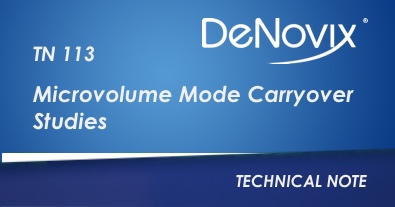Fresh 1.0 μL aliquots were used for each replicate measurement. The sample solution was removed between each measurement by wiping the upper and lower sample surfaces with a clean, dry laboratory wipe.
The second study assessed the carryover of a solution of ~20 mg/mL BSA. The measurement sequence was as described above, substituting the BSA for the nucleic acid sample and PBS for dH20.
Results
As seen in Tables 1 and 2, the blank solution measured both before and after the nucleic acid and protein samples were below the DS-11 lower detection limit.
Ultra high concentration protein samples may require more rigorous wiping between samples. A study using a high concentration BSA sample showed a lack of carryover when surfaces were vigorously wiped using a dry lab wipe between BSA measurements. Subsequent PBS measurements met the expected results of being within the +/- 0.1 mg/mL lower detection limit of the instrument.
Table 1: dsDNA and BSA Carryover| Sample | ng/µL | Sample | mg/mL |
|---|---|---|---|
| dH20 | 0 | PBS | -0.06 |
| dH20 | -0.9 | PBS | -0.05 |
| dsDNA | 5157.3 | BSA | 21.15 |
| dsDNA | 5078.2 | BSA | 20.94 |
| dsDNA | 5094.65 | BSA | 21.07 |
| dH20 | 0.65 | PBS | -0.06 |
| dH20 | 0.9 | PBS | -0.1 |
| Sample (n=5) | Average mg/mL |
|---|---|
| BSA | 313.89 |
| PBS | -0.004 |
Summary
The studies demonstrated a lack of significant carryover for either high concentrations of nucleic acid or protein samples. The DS-11 microvolume measurement surfaces facilitate easy cleanup to ensure minimal-to-no carryover of high concentration samples.
Other DS-Series instruments include the same measurement surfaces as the DS-11, including the DS-8X Eight Channel Spectrophotometer, the DS-7 Spectrophotometer, and the Helium Spectrophotometer.
27-MAR-2025



